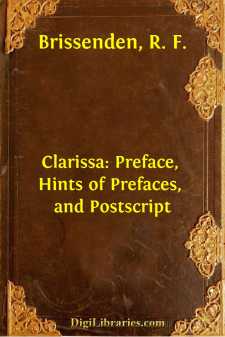Categories
- Antiques & Collectibles 13
- Architecture 36
- Art 48
- Bibles 22
- Biography & Autobiography 813
- Body, Mind & Spirit 142
- Business & Economics 28
- Children's Books 15
- Children's Fiction 12
- Computers 4
- Cooking 94
- Crafts & Hobbies 4
- Drama 346
- Education 46
- Family & Relationships 57
- Fiction 11828
- Games 19
- Gardening 17
- Health & Fitness 34
- History 1377
- House & Home 1
- Humor 147
- Juvenile Fiction 1873
- Juvenile Nonfiction 202
- Language Arts & Disciplines 88
- Law 16
- Literary Collections 686
- Literary Criticism 179
- Mathematics 13
- Medical 41
- Music 40
- Nature 179
- Non-Classifiable 1768
- Performing Arts 7
- Periodicals 1453
- Philosophy 64
- Photography 2
- Poetry 896
- Political Science 203
- Psychology 42
- Reference 154
- Religion 513
- Science 126
- Self-Help 84
- Social Science 81
- Sports & Recreation 34
- Study Aids 3
- Technology & Engineering 59
- Transportation 23
- Travel 463
- True Crime 29
Clarissa: Preface, Hints of Prefaces, and Postscript
by: R. F. Brissenden
Categories:
Description:
Excerpt
INTRODUCTION
The seven volumes of the first edition of Clarissa were published in three instalments during the twelve months from December 1747 to December 1748. Richardson wrote a Preface for Volume I and a Postscript for Volume VII, and William Warburton supplied an additional Preface for Volume III (or IV).
A second edition, consisting merely of a reprint of Volumes I-IV was brought out in 1749. In 1751 a third edition of eight volumes in duodecimo and a fourth edition of seven volumes in octavo were published simultaneously.For the third and fourth editions the author revised the text of the novel, rewrote his own Preface and Postscript, substantially expanding the latter, and dropped the Preface written by Warburton. The additions to the Postscript, like the letters and passages 'restored' to the novel itself, are distinguished in the new editions by points in the margin.
The revised Preface and Postscript, which in the following pages are reproduced from the fourth edition, constitute the most extensive and fully elaborated statement of a theory of fiction ever published by Richardson. The Preface and concluding Note to Sir Charles Grandison are, by comparison, brief and restricted in their application; while the introductory material in Pamela is, so far as critical theory is concerned, slight and incoherent.
The Hints of Prefaces for Clarissa, a transcript of which is also included in this publication, is an equally important and in some ways an even more interesting document. It appears to have been put together by Richardson while he was revising the Preface and Postscript to the first edition. Certain sections of it are preliminary drafts of some of the new material incorporated in the revised Postscript. Large portions of Hints of Prefaces, however, were not used then and have never previously appeared in print. Among these are two critical assessments of the novel by Philip Skelton and Joseph Spence; and a number of observations—some merely jottings—by Richardson himself on the structure of the novel and the virtues of the epistolary style. The statements of Skelton and Spence are unusual amongst contemporary discussions of Clarissa for their brevity, lucidity, and sustained critical relevance. Richardson's own comments, though disorganized and fragmentary, show that he was attempting to develop a theory of the epistolary novel as essentially dramatic, psychologically realistic, and inherently superior to 'the dry Narrative', particularly as exemplified in the novels of Henry Fielding.
It is impossible to determine how much of Hints of Prefaces or of the published Preface and Postscript is Richardson's own work. All were to some extent the result of collaborative effort, and Richardson did not always distinguish clearly between what he had written and what had been supplied by other people. The concluding paragraph of the Postscript, for example, appears in the first edition to be the work of Richardson himself, although in the revised version he indicates that it was composed by someone else....


